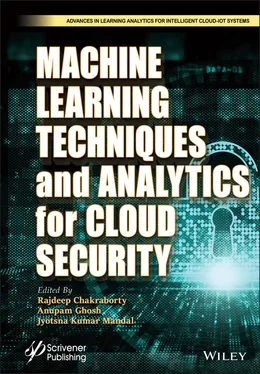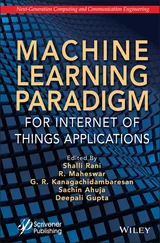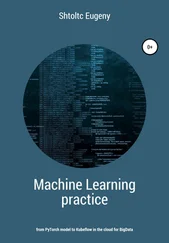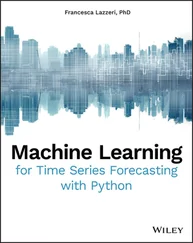Machine Learning Techniques and Analytics for Cloud Security
Здесь есть возможность читать онлайн «Machine Learning Techniques and Analytics for Cloud Security» — ознакомительный отрывок электронной книги совершенно бесплатно, а после прочтения отрывка купить полную версию. В некоторых случаях можно слушать аудио, скачать через торрент в формате fb2 и присутствует краткое содержание. Жанр: unrecognised, на английском языке. Описание произведения, (предисловие) а так же отзывы посетителей доступны на портале библиотеки ЛибКат.
- Название:Machine Learning Techniques and Analytics for Cloud Security
- Автор:
- Жанр:
- Год:неизвестен
- ISBN:нет данных
- Рейтинг книги:3 / 5. Голосов: 1
-
Избранное:Добавить в избранное
- Отзывы:
-
Ваша оценка:
- 60
- 1
- 2
- 3
- 4
- 5
Machine Learning Techniques and Analytics for Cloud Security: краткое содержание, описание и аннотация
Предлагаем к чтению аннотацию, описание, краткое содержание или предисловие (зависит от того, что написал сам автор книги «Machine Learning Techniques and Analytics for Cloud Security»). Если вы не нашли необходимую информацию о книге — напишите в комментариях, мы постараемся отыскать её.
This book covers new methods, surveys, case studies, and policy with almost all machine learning techniques and analytics for cloud security solutions
Audience The aim of Machine Learning Techniques and Analytics for Cloud Security
Machine Learning Techniques and Analytics for Cloud Security — читать онлайн ознакомительный отрывок
Ниже представлен текст книги, разбитый по страницам. Система сохранения места последней прочитанной страницы, позволяет с удобством читать онлайн бесплатно книгу «Machine Learning Techniques and Analytics for Cloud Security», без необходимости каждый раз заново искать на чём Вы остановились. Поставьте закладку, и сможете в любой момент перейти на страницу, на которой закончили чтение.
Интервал:
Закладка:
346 349
347 350
348 351
349 352
350 353
351 354
352 355
353 357
354 358
355 359
356 360
357 361
358 362
359 363
360 364
361 365
362 366
363 367
364 368
365 369
366 370
367 371
368 372
369 373
370 374
371 375
372 376
373 377
374 379
375 381
376 382
377 383
378 384
379 385
380 386
381 387
382 388
383 389
384 390
385 391
386 392
387 393
388 394
389 395
390 396
391 397
392 398
393 399
394 400
395 401
396 402
397 403
398 404
399 405
400 406
401 407
402 408
403 409
404 410
405 411
406 412
407 413
408 414
409 415
410 417
411 418
412 419
413 420
414 421
415 422
416 423
417 424
418 425
419 426
420 427
421 428
422 429
423 430
424 431
425 432
426 433
427 434
428 435
429 436
430 437
431 438
432 439
433 440
434 441
435 442
436 443
437 444
Scrivener Publishing100 Cummings Center, Suite 541J Beverly, MA 01915-6106
Advances in Learning Analytics for Intelligent Cloud-IoT Systems
Series Editor: Dr. Souvik Pal and Dr. Dac-Nhuong Le
The role of adaptation, learning analytics, computational Intelligence, and data analytics in the field of cloud-IoT systems is becoming increasingly essential and intertwined. The capability of an intelligent system depends on various self-decision-making algorithms in IoT devices. IoT-based smart systems generate a large amount of data (big data) that cannot be processed by traditional data processing algorithms and applications. Hence, this book series involves different computational methods incorporated within the system with the help of analytics reasoning and sense-making in big data, which is centered in the cloud and IoT-enabled environments. The series publishes volumes that are empirical studies, theoretical and numerical analysis, and novel research findings.
Submission to the series:
Please send proposals to Dr. Souvik Pal, Department of Computer Science and Engineering, Global Institute of Management and Technology, Krishna Nagar, West Bengal, India.
E-mail: souvikpal22@gmail.com
Publishers at Scrivener
Martin Scrivener ( martin@scrivenerpublishing.com)
Phillip Carmical ( pcarmical@scrivenerpublishing.com)
Machine Learning Techniques and Analytics for Cloud Security
Edited by
Rajdeep Chakraborty
Anupam Ghosh
and
Jyotsna Kumar Mandal

This edition first published 2022 by John Wiley & Sons, Inc., 111 River Street, Hoboken, NJ 07030, USA and Scrivener Publishing LLC, 100 Cummings Center, Suite 541J, Beverly, MA 01915, USA
© 2022 Scrivener Publishing LLC
For more information about Scrivener publications please visit www.scrivenerpublishing.com.
All rights reserved. No part of this publication may be reproduced, stored in a retrieval system, or transmitted, in any form or by any means, electronic, mechanical, photocopying, recording, or otherwise, except as permitted by law. Advice on how to obtain permission to reuse material from this title is available at http://www.wiley.com/go/permissions.
Wiley Global Headquarters
111 River Street, Hoboken, NJ 07030, USA
For details of our global editorial offices, customer services, and more information about Wiley products visit us at www.wiley.com.
Limit of Liability/Disclaimer of Warranty
While the publisher and authors have used their best efforts in preparing this work, they make no representations or warranties with respect to the accuracy or completeness of the contents of this work and specifically disclaim all warranties, including without limitation any implied warranties of merchant-ability or fitness for a particular purpose. No warranty may be created or extended by sales representatives, written sales materials, or promotional statements for this work. The fact that an organization, website, or product is referred to in this work as a citation and/or potential source of further information does not mean that the publisher and authors endorse the information or services the organization, website, or product may provide or recommendations it may make. This work is sold with the understanding that the publisher is not engaged in rendering professional services. The advice and strategies contained herein may not be suitable for your situation. You should consult with a specialist where appropriate. Neither the publisher nor authors shall be liable for any loss of profit or any other commercial damages, including but not limited to special, incidental, consequential, or other damages. Further, readers should be aware that websites listed in this work may have changed or disappeared between when this work was written and when it is read.
Library of Congress Cataloging-in-Publication Data
ISBN 978-1-119-76225-6
Cover images: Pixabay.Com
Cover design by Russell Richardson
Set in size of 11pt and Minion Pro by Manila Typesetting Company, Makati, Philippines
Printed in the USA
10 9 8 7 6 5 4 3 2 1
Preface
Our objective in writing this book was to provide the reader with an in-depth knowledge of how to integrate machine learning (ML) approaches to meet various analytical issues in cloud security deemed necessary due to the advancement of IoT networks. Although one of the ways to achieve cloud security is by using ML, the technique has long-standing challenges that require methodological and theoretical approaches. Therefore, because the conventional cryptographic approach is less frequently applied in resource-constrained devices, the ML approach may be effectively used in providing security in the constantly growing cloud environment. Machine learning algorithms can also be used to meet various cloud security issues for effective intrusion detection and zero-knowledge authentication systems. Moreover, these algorithms can also be used in applications and for much more, including measuring passive attacks and designing protocols and privacy systems. This book contains case studies/projects for implementing some security features based on ML algorithms and analytics. It will provide learning paradigms for the field of artificial intelligence and the deep learning community, with related datasets to help delve deeper into ML for cloud security.
This book is organized into five parts. As the entire book is based on ML techniques, the three chapters contained in “Part I: Conceptual Aspects of Cloud and Applications of Machine Learning,” describe cloud environments and ML methods and techniques. The seven chapters in “Part II: Cloud Security Systems Using Machine Learning Techniques,” describe ML algorithms and techniques which are hard coded and implemented for providing various security aspects of cloud environments. The four chapters of “Part III: Cloud Security Analysis Using Machine Learning Techniques,” present some of the recent studies and surveys of ML techniques and analytics for providing cloud security. The next three chapters in “Part IV: Case Studies Focused on Cloud Security,” are unique to this book as they contain three case studies of three cloud products from a security perspective. These three products are mainly in the domains of public cloud, private cloud and hybrid cloud. Finally, the two chapters in “Part V: Policy Aspects,” pertain to policy aspects related to the cloud environment and cloud security using ML techniques and analytics. Each of the chapters mentioned above are individually highlighted chapter by chapter below.
Читать дальшеИнтервал:
Закладка:
Похожие книги на «Machine Learning Techniques and Analytics for Cloud Security»
Представляем Вашему вниманию похожие книги на «Machine Learning Techniques and Analytics for Cloud Security» списком для выбора. Мы отобрали схожую по названию и смыслу литературу в надежде предоставить читателям больше вариантов отыскать новые, интересные, ещё непрочитанные произведения.
Обсуждение, отзывы о книге «Machine Learning Techniques and Analytics for Cloud Security» и просто собственные мнения читателей. Оставьте ваши комментарии, напишите, что Вы думаете о произведении, его смысле или главных героях. Укажите что конкретно понравилось, а что нет, и почему Вы так считаете.












